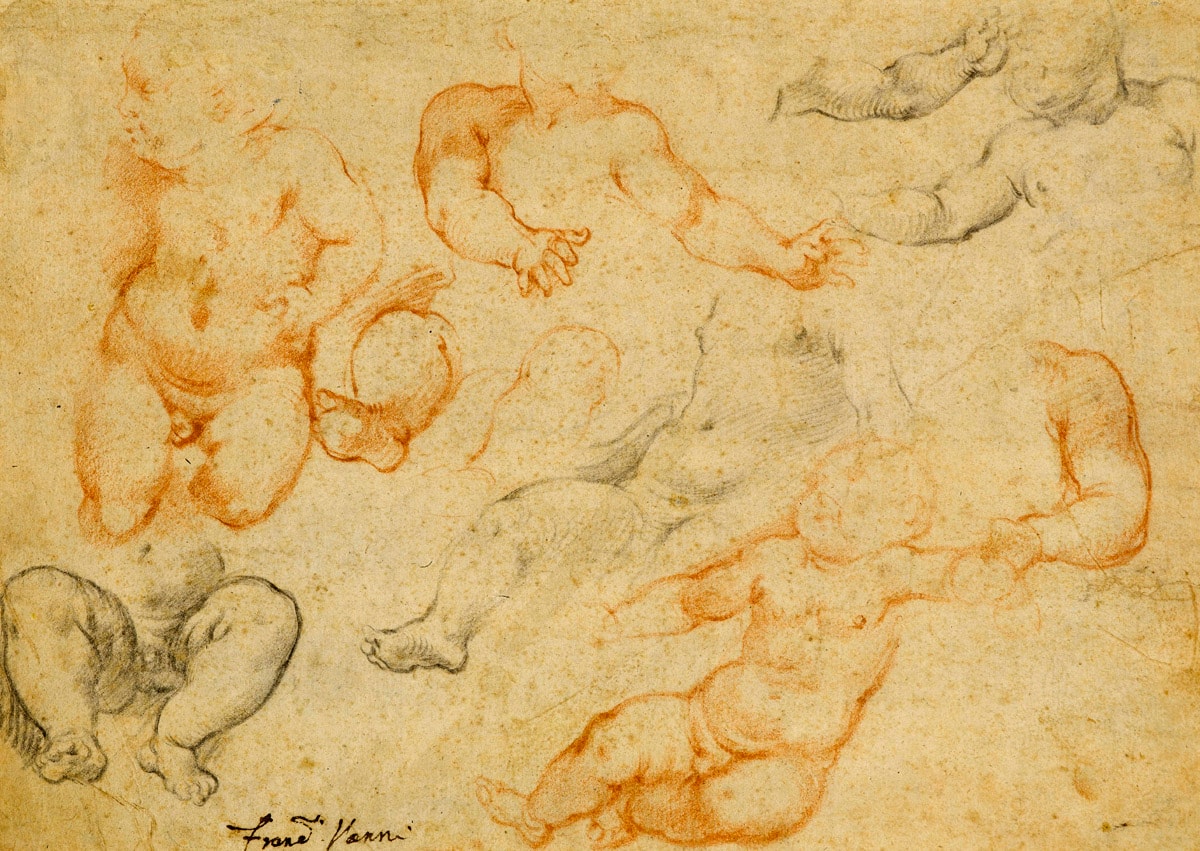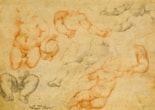Francesco VANNI
(Siena 1563 - Siena 1610)
A Sheet of Studies of a Young Child
Sold
Red and black chalk.
Inscribed Franc.o Vanni at the lower left.
179 x 254 mm. (7 x 10 in.)
ACQUIRED BY THE YALE UNIVERSITY ART GALLERY, NEW HAVEN, CT.
Inscribed Franc.o Vanni at the lower left.
179 x 254 mm. (7 x 10 in.)
ACQUIRED BY THE YALE UNIVERSITY ART GALLERY, NEW HAVEN, CT.
The present sheet of studies may be related to two altarpieces by Francesco Vanni of the late 1590’s. Both the sketch in black chalk of a child’s legs and lower torso at the lower left and the study in red chalk of an arm and shoulder at the right centre of the sheet are studies for the pose of the Christ Child in Vanni’s altarpiece of The Virgin and Child with Saints Bernardino of Siena, Francis and Leonard in the small Capuchin church on the outskirts of the towns of Arcidosso and Castel del Piano, south of Siena. One of Vanni’s finest altarpieces, the painting is fully signed and dated, and was completed in 1593, around the same time the convent church was built. In the painting, the Christ Child holds an orb, and his legs are partly covered with drapery.
The remaining studies on this sheet are related to the figure of the Christ Child in The Madonna and Child with Saints Cecilia and Agnes in the Sienese church of Sant’Agnese a Vignano, datable to between 1595 and 1600. The study of a reclining child in red chalk at the bottom centre of the sheet is very close to the pose of the child in the painting, although in reverse. Just above this sketch is a definitive study in black chalk for the extended leg of the Child, again in reverse. The red chalk study of arms at the top centre and the black chalk studies at the upper right of the sheet are studies for the arms of the Child, which in the painting reach out to place a garland on the head of Saint Cecilia.
The inscription Franc.o Vanni at the bottom of the sheet, written in a 17th century hand, is identical to that found on a drawing by Vanni in the collection of the Uffizi in Florence.
The remaining studies on this sheet are related to the figure of the Christ Child in The Madonna and Child with Saints Cecilia and Agnes in the Sienese church of Sant’Agnese a Vignano, datable to between 1595 and 1600. The study of a reclining child in red chalk at the bottom centre of the sheet is very close to the pose of the child in the painting, although in reverse. Just above this sketch is a definitive study in black chalk for the extended leg of the Child, again in reverse. The red chalk study of arms at the top centre and the black chalk studies at the upper right of the sheet are studies for the arms of the Child, which in the painting reach out to place a garland on the head of Saint Cecilia.
The inscription Franc.o Vanni at the bottom of the sheet, written in a 17th century hand, is identical to that found on a drawing by Vanni in the collection of the Uffizi in Florence.
The leading painter in Siena at the end of the 16th century, Francesco Vanni began his training with his stepfather Arcangelo Salimbeni before entering the studio of Giovanni de’ Vecchi in Rome around 1581. Perhaps the most significant influence on the artist, however, was the work of Federico Barocci. For most of his career Vanni worked in and around Siena, where one of his earliest independent commissions was a Baptism of Constantine for the church of Sant’Agostino, painted in 1586. Later paintings followed for San Domenico, Santa Caterina, San Francesco and several other Sienese churches, including a Mystic Marriage of Saint Catherine painted in 1601 for the Chiesa del Rifugio. Vanni also worked in Pistoia, Cortona, Pisa and Rome, where he painted two scenes from the life of Saint Cecilia for the church of Santa Cecilia in Trastevere and a large altarpiece of The Fall of Simon Magus for St. Peter’s, completed in 1603. Together with his half-brother Ventura Salimbeni, Francesco Vanni came to dominate the artistic scene in Siena at the turn of the century.
Vanni was a gifted and prolific draughtsman, whose drawings were highly regarded by Sienese artists of the late 16th and 17th centuries, in much the same way that Domenico Beccafumi’s drawings had a profound influence on artists of the previous generation. Vanni’s drawings were also in great demand among such contemporary collectors as Cardinal Leopoldo de’ Medici, who wrote in 1573 to his agent in Siena, charged with acquiring drawings by local artists, that ‘of those by Vanni I would take up to a hundred, so as to be able to form a special book [album] of them all.’ Several hundred drawings by Vanni survive today, with large groups in the Uffizi, the Louvre, the Kupferstichkabinet in Berlin and the Biblioteca Comunale in Siena.
Provenance
An unidentified 17th century collector, with his inscription 'Franc.o Vanni' at the lower left
Anonymous sale, London, Phillips, 11 December 1991, lot 287
Private collection.





